If you want to get more clicks from search results, you need to optimize how your site looks in those search results. A single result in a set of search results is called a snippet. The Yoast SEO plugin has a snippet preview, which shows a simulation of what your post will look like in those results. This post explains how to use that snippet preview to get more clicks! It also describes why the snippet might not always match what you see in the search results.
Our Yoast SEO plugin allows you to preview two versions of your snippet: the mobile snippet and the desktop snippet. A button below lets you switch between the two and make sure they both look good. Note that the screenshots in this post are made using the latest version of Yoast SEO. This version has the mobile version as default. So if you’re thinking “this is different from what I’m seeing,” you need to update!
Here’s an example of our snippet preview in action:
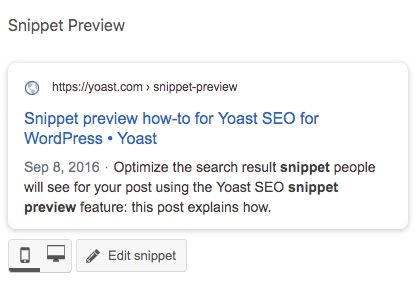
What determines how a snippet looks in search results?
If you search for a specific word, Google will make that keyword bold in the text and URL of the snippets it displays. But it actually goes one step further. Once it has decided which pages will rank for your search, it tries to find part of the page that includes that exact term. If your meta description doesn’t contain the keyword searched for, it’ll grab a “random” snippet from the page that does.
This is one of the reasons why it helps tremendously if you know what the most searched for keyword for a page is likely to be. So you can optimize the snippet for it. In our Yoast SEO plugin, you can set the focus keyword or keyphrase of your post. That word will then automatically be displayed in bold:
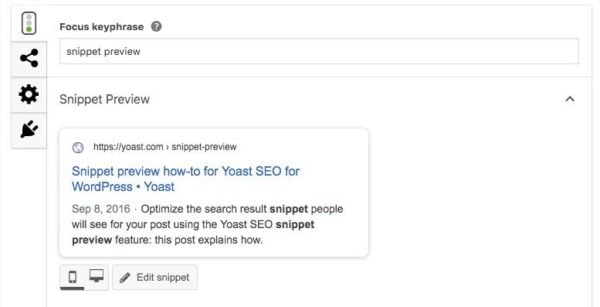
As you can see, the plugin “adapts” by making the focus keyword in the description bold, just like Google would. Incidentally, Google has now stopped displaying keywords in page titles in bold. Google also shows a favicon next to the URL.
The title
The title is the first thing people see in the search results for your posts and pages, and in many, many cases it’s the only thing – so it had better be good! Funnily enough, if it thinks you’re not doing a good enough job of your title, Google actually changes it for you. There are many reasons why this happens, we’ve explained most of them in this post.
The title in the snippet preview is determined by the title template you’ve set in your SEO → Search appearance settings → Content Types, using variables from your current post. We use the default template for our site:
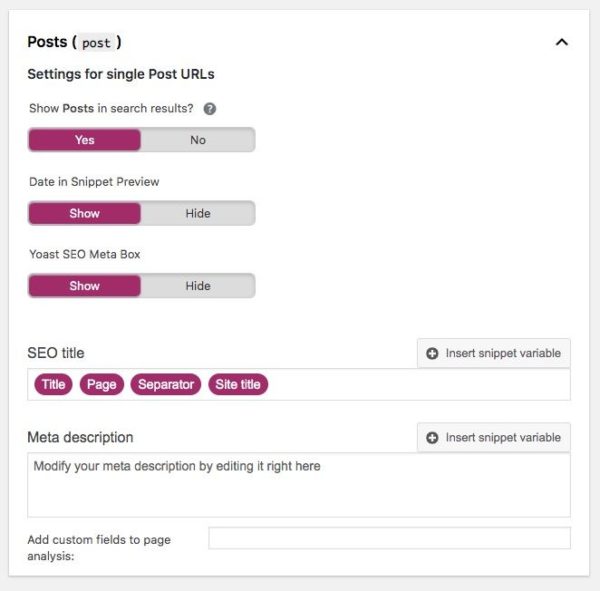
As you can see the plugin takes the post title and adds the separator (in our case a middle dot) plus the site name. The page number parameter is only used when you have a paginated post. You could also have the category in there if you wanted, but that reduces the space to properly play with the title. Removing the site’s name is not a good idea. Google will usually rewrite your titles if they don’t contain branding – again, see the post on page titles for more information.
Of course, Yoast SEO allows you to use different wording for your title and main heading and in some cases, that’s a good idea. If you’ve done some keyword research to determine the focus keyword for your page, you may have noticed there are several variations of that keyword. For instance, for our keyword “snippet preview”, Google Suggest shows the following:
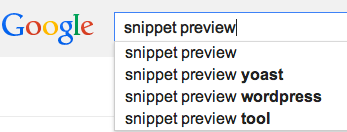
Now, our current title would definitely match for [snippet preview yoast], and we’d like it to match for [snippet preview wordpress] too. Also, running the words snippet preview through our Yoast Suggest actually suggests there are some how-to type queries for the keyword as well, so I’ve optimized this post for all those keywords with Yoast SEO Premium’s multiple focus keywords feature.
So let’s combine all that knowledge and change our title tag to “Snippet preview how-to for Yoast SEO for WordPress • Yoast”. At first, I wanted to make the title “A how-to for the snippet preview in Yoast SEO for WordPress • Yoast”, but that was too long. So, I changed it to:
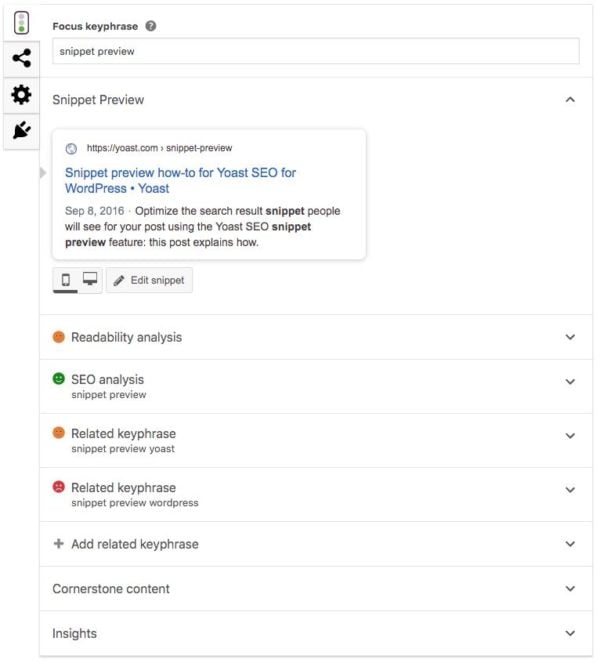
Now that our title is up to snuff, let’s work on the second biggest “item” in the snippet: the meta description. Often referred to as the “snippet” tool, though that might be slightly confusing in this context. We want to control what Google displays in its results snippets for our pages as often as possible. This means that we should have a snippet that matches many of the keywords that’ll match this post.
We know that we want people to be able to search for [snippet preview] and preferably also [snippet preview how-to] and [snippet preview yoast]. So, let’s write our meta description. The snippet preview updates in real time as you write your meta description, so you can test what works and fits, lengthwise. I ended up with this:
Optimize the search result snippet people will see for your post using the Yoast SEO snippet preview feature: this post explains how.
Before we move on to another screenshot, let’s go to the next section of the preview.
The URL or “slug”
The slug is the part of the URL that identifies your article. So in our example above it was “the-snippet-preview-means” etc. Slugs in WordPress are normally the article title, in lowercase, with spaces replaced by hyphens. As we’ve opted to change the title of our post, we’ve edited the slug as well, simply to “snippet-preview”.
The date
This is a post, and posts carry date info in Google search. Some SEOs, including us, have tried hiding this in the past. To be honest, that’s a sacrifice to usability we’re not prepared to make anymore. So, there won’t be a date in the snippet preview for pages and other post types, as usually, these don’t display dates.
If you want to change that behavior for a particular post type, go to SEO → Search Appearance and check the box below the post type:
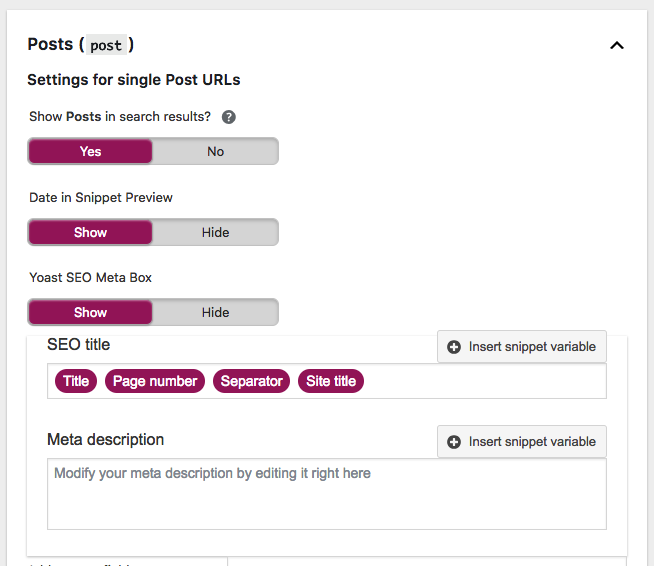
Use the snippet preview to optimize your posts
I hope this post has made it clear how you can use the snippet preview to increase click-throughs from the search results. This functionality is available in our Yoast SEO plugin and of course in Yoast SEO Premium as well.
If you’re unsure about whether you’re getting the best out of Yoast SEO, our Yoast SEO for WordPress training might be something for you! Be sure to check it out.
Read more: How to create the right meta description »
